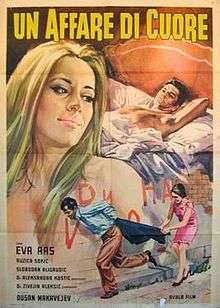Love Affair, or the Case of the Missing Switchboard Operator
Love Affair, or the Case of the Missing Switchboard Operator (Serbo-Croatian: Ljubavni slučaj ili tragedija službenice P.T.T.) is a 1967 Yugoslav film directed by Dušan Makavejev.
| Love Affair, or the Case of the Missing Switchboard Operator | |
|---|---|
 Italian Movie Poster | |
| Directed by | Dušan Makavejev |
| Written by | Dušan Makavejev Branko Vučićević |
| Starring | Eva Ras Slobodan Aligrudić |
| Cinematography | Aleksandar Petković |
| Edited by | Katarina Stojanović |
Production company | |
Release date | 1967 |
Running time | 79 minutes |
| Country | Yugoslavia |
| Language | Serbo-Croatian |
Plot
The film begins with a sexologist in his office, talking about the history of sex.
Izabela (Eva Ras), a Hungarian switchboard operator, meets and falls in love with a Sandžak Muslim sanitation inspector named Ahmed (Slobodan Aligrudić), who soon moves into her apartment and has a bathtub installed. The film then cuts away to a police investigation of the death of a young woman by drowning. Ahmed goes away on business for a month. During his absence, Izabela finally gives in to a persistently amorous postman.
When Ahmed returns, he finds Izabela different, less loving. (She has found out she is pregnant.) He gets very drunk, and when Isabella chases after him to keep him from harm, he threatens to commit suicide by jumping into an underground vat of water. However, Ahmed ends up accidentally pushing Izabela in instead, killing her. He goes into hiding, but is arrested by the police for murder. The film concludes with a scene of Ahmed and Izabela walking down a staircase.
Cast
- Eva Ras - Izabela
- Slobodan Aligrudić - Ahmed
- Ružica Sokić - Ruza
- Miodrag Andrić - Mica
Analysis
The plot of this typical "film noir"[1] of the film is not its main message. This masterpiece created a revolution because of the image of naked Isabella with a black cat on her back, one of the most iconic scenes in Yugoslav film history. The film is more a judgement of society on communist regime in that time, and how sexuality, freedom of living and art was banned and restricted by people in power.
The film was also considerably unconventional and revolutionary at the time as it incorporated instances of people talking towards the screen, with a sexologist and criminologist both addressing the audience in separate sections of the film. It was also one of the first films to create a plot that was not chronological, with the narrative jumping from one point in time to another.
Home media
It was released as part of the three-film DVD collector's set Eclipse Series 18: Dušan Makavejev—Free Radical by the Criterion Collection.[2]
References
- See, e.g., Biesen (2005), p. 1; Hirsch (2001), p. 9; Lyons (2001), p. 2; Silver and Ward (1992), p. 1; Schatz (1981), p. 112. Outside the field of noir scholarship, "dark film" is also offered on occasion; see, e.g., Block, Bruce A., The Visual Story: Seeing the Structure of Film, TV, and New Media (2001), p. 94; Klarer, Mario, An Introduction to Literary Studies (1999), p. 59.
- "Eclipse Series 18: Dušan Makavejev—Free Radical". The Criterion Collection.